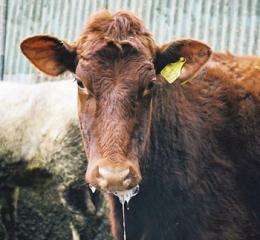Foot and mouth disease may spread through skin cells

(Medical Xpress) -- Skin cells shed from livestock infected with foot and mouth disease could very well spread the disease.
In a new paper appearing in the Proceedings of the Royal Society B, Lawrence Livermore National Laboratory scientist Michael Dillon proposed that virus-infected skin cells could be a source of infectious foot and mouth disease virus aerosols. His proposal is based on the facts that foot and mouth disease virus is found in skin and that airborne skin cells are known to transmit other diseases.
The proposal could lead to new methods for surveillance for foot and mouth disease (as in settled dust), the development of more effective control measures, and improved studies of the persistence of the disease in the environment. The research also may be applicable to how other infectious diseases are spread.
Foot and mouth is a highly contagious viral disease capable of causing widespread epidemics in livestock. The foot and mouth disease virus (FMDV) has multiple known routes of transmission. These include direct contact (animal-to-animal contact at mucous membranes, cuts or abrasions), indirect contact (such as contaminated bedding), ingestion (contaminated feed) and the respiratory or airborne pathway (inhalation of infectious aerosols).
"The airborne pathway may play a role in some outbreaks by causing disease 'sparks' (disease spread to regions remote from a primary infection site)," Dillon said. "If the disease isn't detected quickly, these 'sparks' can lead to major outbreaks."
Dillon cited the widespread dissemination of FMDV during the catastrophic 2001 United Kingdom outbreak, which is thought to be caused by the inadvertent transport of animals with unrecognized FMDV infection from a Prestwick area farm to areas previously free of FMDV.
Mammals actively shed skin cells into the environment. Skin cells comprise a significant fraction (1 percent to 10 percent) of measured indoor and outdoor aerosols and indoor dust. These cells; and the bacteria, yeast, fungi and viruses known to be present on the surface of (or in some cases inside) skin cells; can become airborne by being shed directly into the air or when dust is disturbed.
"Infectious material can become airborne on skin cells and cause infection when inhaled or deposited directly onto the skin of the new host," Dillon said. "This is believed to be a significant source of bacterial infection for surgical procedures and other infections that are a result of treatment in a hospital."
"While not a typical site for the initial FMDV infection, the skin is a major viral replication site in most animals," Dillon said. "The outermost layer of FMDV-infected skin needs to be analyzed to find out how stable the virus is in these skin cells."
Dillon's proposal suggests a number of practical possibilities for FMDV surveillance and control:
• The sampling and management of settled dust could prove to be a useful tool for disease surveillance and control.
• Slaughtered animals may emit airborne FMDV via infected skin cells simply by exposure to wind and/or mechanical abrasion (e.g. moving animal carcasses, spraying hides with water).
• Airborne emissions from cattle and sheep may need to be revisited as infected skin cells trapped in hair may later become airborne (currently these animals are believed to contribute little to aerosol emissions relative to swine).
"Given the potential for skin cells to protect infectious virus from the environment, the management of other viral diseases may also benefit from enhanced dust surveillance and management, and skin decontamination," Dillon said.
More information: Skin as a potential source of infectious foot and mouth disease aerosols, Proceedings of the Royal Society B, Published online before print March 30, 2011, doi:10.1098/rspb.2010.2430
Abstract
This review examines whether exfoliated, virus-infected animal skin cells could be an important source of infectious foot and mouth disease virus (FMDV) aerosols. Infectious material rafting on skin cell aerosols is an established means of transmitting other diseases. The evidence for a similar mechanism for FMDV is: (i) FMDV is trophic for animal skin and FMDV epidermis titres are high, even in macroscopically normal skin; (ii) estimates for FMDV skin cell aerosol emissions appear consistent with measured aerosol emission rates and are orders of magnitude larger than the minimum infectious dose; (iii) the timing of infectious FMDV aerosol emissions is consistent with the timing of high FMDV skin concentrations; (iv) measured FMDV aerosol sizes are consistent with skin cell aerosols; and (v) FMDV stability in natural aerosols is consistent with that expected for skin cell aerosols. While these findings support the hypothesis, this review is insufficient, in and of itself, to prove the hypothesis and specific follow-on experiments are proposed. If this hypothesis is validated, (i) new FMDV detection, management and decontamination approaches could be developed and (ii) the relevance of skin cells to the spread of viral disease may need to be reassessed as skin cells may protect viruses against otherwise adverse environmental conditions.














